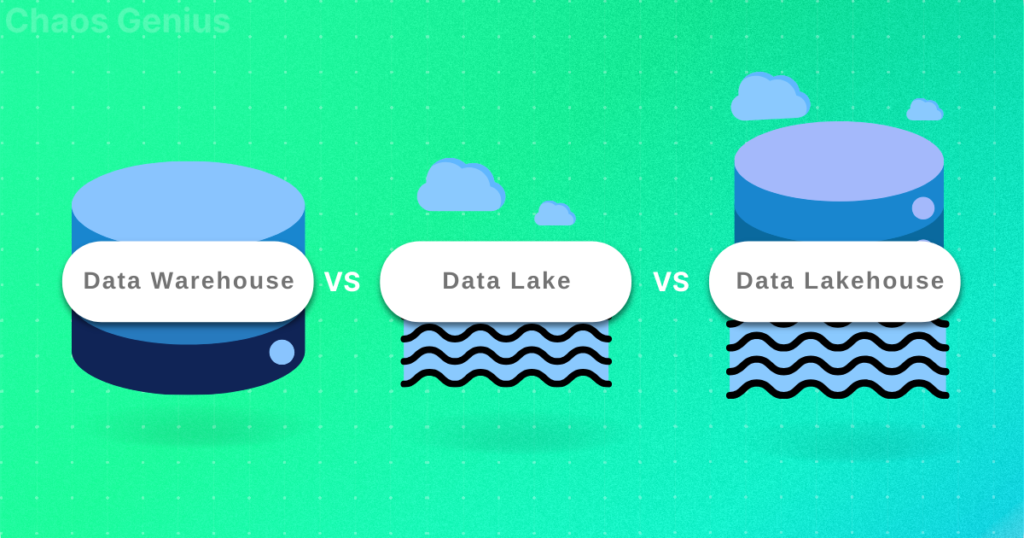Data Warehouse vs Data Lake vs Lakehouse
In the era of big data, choosing the right storage and analytics architecture is crucial for turning raw data into actionable insights. As organizations scale and diversify their data sources, they often find themselves choosing between a data warehouse, a data lake, or a more modern hybrid: the data lakehouse.
Each of these solutions has its own strengths, limitations, and ideal use cases. In this post, we’ll break down the key differences between a data warehouse, data lake, and data lakehouse to help you make an informed decision for your data strategy.

What is a Data Warehouse?
A data warehouse is a centralized system designed specifically for reporting and data analysis. It stores structured data that has been cleaned, transformed, and loaded from transactional systems or other data sources. Data warehouses are optimized for high-speed queries and business intelligence (BI) applications.
Key Characteristics:
- Structured Data Only: Stores data in tables with defined schemas.
- Schema-on-Write: Data must fit a predefined format before storage.
- High Performance: Optimized for SQL-based analytics and reporting.
- Use Cases: Ideal for KPI dashboards, executive reports, and OLAP.
- Examples: Snowflake, Amazon Redshift, Google BigQuery, Microsoft Azure Synapse.
You can learn about Data Warehouse here : Why is Data Warehouse required ?
What is a Data Lake?
A data lake is a vast storage repository that holds raw data in its native format, including structured, semi-structured, and unstructured data. It is often built on low-cost, scalable storage platforms and used for big data analytics and machine learning.
Key Characteristics:
- All Data Types: Structured, semi-structured (JSON, XML), and unstructured (images, videos, text).
- Schema-on-Read: Data is stored as-is, and structure is applied when it’s read.
- Highly Scalable: Can handle petabytes of data across various formats.
- Use Cases: Ideal for data science, machine learning, IoT data ingestion, and exploratory analytics.
- Examples: Hadoop, AWS S3, Azure Data Lake, Google Cloud Storage.
You can also learn more about Data Lake here : What is Data Lake ?
What is a Data Lakehouse?
A data lakehouse is a modern architecture that combines the best features of both data lakes and data warehouses. It allows you to store data in open formats (like a data lake) while enabling high-performance analytics and ACID transactions (like a warehouse).
This hybrid model reduces data movement, simplifies architecture, and supports both BI and advanced analytics from a single platform.
Key Characteristics:
- Unified Platform: Combines the flexibility of data lakes with the performance of warehouses.
- Open File Formats: Uses formats like Parquet or Delta Lake for better interoperability.
- Low Latency & Reliability: Supports fast queries and transactional guarantees.
- Use Cases: Real-time analytics, unified data engineering, and ML/BI workloads.
- Examples: Databricks Lakehouse, Delta Lake, Apache Iceberg, Snowflake Unistore.
Data Warehouse vs Data Lake vs Lakehouse: Comparison Table
| Feature | Data Warehouse | Data Lake | Data Lakehouse |
|---|---|---|---|
| Data Types | Structured | Structured, Semi-structured, Unstructured | All Data Types |
| Schema | Schema-on-Write | Schema-on-Read | Hybrid (Schema-on-Write & Read) |
| Performance | High for BI | Low (unless enhanced) | High (near warehouse speeds) |
| Storage Cost | Higher | Lower | Moderate |
| Data Governance | Strong | Weak | Improved with modern tools |
| Use Cases | BI, Dashboards, Reports | AI, ML, Data Science | Unified Analytics, Real-time BI + ML |
| Examples | Snowflake, Redshift | Hadoop, AWS S3 | Databricks, Delta Lake, Iceberg |
Which One Should You Use?
The choice between a data warehouse, data lake, and lakehouse depends on your organization’s current and future data needs:
- Use a Data Warehouse if your primary goal is fast, structured reporting and traditional BI.
- Choose a Data Lake if you need to collect massive, diverse data for experimentation, ML, and data exploration.
- Adopt a Data Lakehouse if you want a unified solution that supports both BI and advanced analytics at scale.
Many modern enterprises are moving toward lakehouse architectures to simplify their data stack, improve agility, and reduce infrastructure costs.
Final Thoughts
As the data landscape evolves, understanding the distinctions between a data warehouse, data lake, and lakehouse becomes critical. Each has unique strengths, but the trend is moving toward unified architectures that deliver both performance and flexibility.
By aligning your data strategy with your business goals—whether it’s real-time analytics, machine learning, or executive reporting—you can choose the right architecture to unlock the full value of your data.